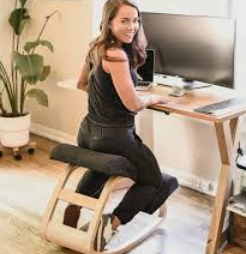Are Kneeling Chairs Good for Hip Flexors? Unveiling the Truth
Are kneeling chairs good for hip flexors in Australia? Yes, kneeling chairs can be good for hip flexors by promoting an open hip angle and active sitting posture. In Australia, they’re popular in ergonomic office setups for reducing strain on the hips and improving core engagement. Regular use can help relieve tension in the hip area and support better posture throughout the day.
The debate around kneeling chairs and their impact on hip flexors is a topic of interest for many looking to improve their sitting habits. Kneeling chairs are often touted for their potential to enhance posture and reduce discomfort, leading to queries like "Are kneeling chairs good for hip pain?" This exploration seeks to shed light on how these innovative chairs might benefit or affect the hip flexors, a crucial aspect of our body's mobility and comfort.
Furthermore, the conversation extends into related areas such as "Are kneeling chairs good for back pain?" Understanding the mechanics of kneeling chairs and their influence on our body's posture and musculoskeletal health is essential. By examining the design and usage of kneeling chairs, this discussion aims to provide clarity on their role in promoting healthier sitting postures and whether they truly offer relief to the hip flexors.
Understanding Kneeling Chairs: An Overview
Kneeling chairs present a unique alternative to traditional seating by encouraging a more active sitting position. This design aims to distribute the user's weight more evenly and reduce the strain on certain body parts, including the hip flexors. The concept behind these chairs is not only to provide comfort but also to promote better posture through active engagement of the muscles.
The Origin and Evolution of Kneeling Chairs
The inception of kneeling chairs can be traced back to the 1970s, born out of the pursuit for ergonomic furniture that supports natural body alignment. Over the decades, these chairs have evolved, incorporating various materials and designs to enhance comfort and functionality. The core principle, however, remains the same: to offer a seating option that encourages better posture and engagement of the muscles.
How Kneeling Chairs Promote Active Sitting
By design, kneeling chairs promote active sitting by engaging the body's core and thigh muscles, rather than allowing them to remain passive. This engagement is crucial for maintaining good posture and reducing the risk of muscle strain and discomfort. The active sitting position encouraged by kneeling chairs is instrumental in alleviating pressure on the hip flexors, potentially offering relief to those experiencing hip pain.
The Mechanics of Kneeling Chairs on Hip Flexors
Kneeling chairs are designed to create a more open hip angle, which can alleviate tension in the hip flexors. This position may contribute to improved posture and comfort during extended periods of sitting.
Aligning Your Posture with Kneeling Chairs
The strategic design of kneeling chairs supports improved posture by encouraging the natural lumbar curvature of the spine. This alignment is beneficial for the core muscles, including the hip flexors, as it promotes a more balanced distribution of weight and reduces strain on the lower back and hips.
Pros
Kneeling chairs offer a range of benefits, including improved posture, engagement of core muscles, and potential relief for back and hip pain. Their unique design encourages active sitting, which can lead to better overall musculoskeletal health. The chairs also promote an increased awareness of one's posture, further contributing to the potential benefits of kneeling chairs for individuals suffering from discomfort related to traditional office chairs.
Cons
Despite the advantages, kneeling chairs may present challenges, such as discomfort during the initial adjustment period and potential pressure on the knees and shins. They may not be suitable for all-day use for everyone, especially for those with pre-existing knee issues. Additionally, the lack of back support in some models may not cater to everyone's needs, highlighting the importance of considering personal comfort and health conditions before making a switch.
The Impact on Hip Flexor Health
Prolonged sitting can lead to tight hip flexors, a common concern for many. Kneeling chairs, designed to open up the hip angle, can potentially offer relief. By encouraging an active sitting posture, these chairs help to promote better posture and reduce the strain on the hip flexors. This can be particularly beneficial for those wondering, "Are kneeling chairs good for hip pain?" While they may not be a cure-all, kneeling chairs can certainly play a role in a more ergonomic seating solution.
Personal Experiences: Transitioning to a Kneeling Chair
Switching to a kneeling chair from a traditional desk chair can be a unique experience. Initially, it might feel unfamiliar and even a bit challenging to adjust. However, many find that after a short period, the benefits become apparent. The active sitting posture can help to alleviate some common discomforts associated with conventional office chairs, leading to an overall improvement in comfort during the workday.
A Week-Long Journey with a Kneeling Chair
Over the course of a week, the transition to a kneeling chair can reveal significant insights. The first few days may involve a mix of adjustment and discovery, as the body adapts to a new way of sitting. By mid-week, the potential benefits for hip and back health start to emerge, answering the question, "Are kneeling chairs good for back pain?" By the end of the week, many report a noticeable difference in how they feel, both during and after work.
Adjusting to the Kneeling Chair Lifestyle
Adopting a kneeling chair requires a period of adjustment, not just physically but also in terms of workspace ergonomics. It's about finding the right balance between time spent kneeling and standing or walking. Regular breaks are essential to maximize the benefits and minimize any discomfort. Over time, users often develop a new appreciation for their workspace and the way they interact with it.
Comparing Kneeling Chairs with Other Active Sitting Options
Terrawellness Kneeling chairs offer a unique alternative to traditional seating options, but they're not the only choice for those seeking to improve their sitting habits. When compared with standing desks, another popular option, kneeling chairs encourage a different type of muscle engagement and body weight distribution. Both options have their own set of benefits and can be used in tandem to create a dynamic and flexible office space.
Kneeling Chairs Vs. Standing Desks
When considering a kneeling chair versus a standing desk, it's important to weigh the benefits of each. Standing desks allow for a greater range of movement and can help in reducing the risks associated with prolonged sitting. However, kneeling chairs offer a more active sitting posture, which can aid in muscle development and provide pain relief for those with specific discomforts. Ultimately, the choice depends on individual needs and workspace constraints.
Alternative Seating Solutions for Active Sitting
Beyond kneeling chairs and standing desks, there are other innovative seating solutions designed to encourage movement and improve posture. Exercise balls, for instance, challenge the core muscles and promote balance. Incorporating regular breaks and varying seating options can further enhance the active sitting experience, making it a beneficial practice for anyone looking to improve their health and productivity at work.
Making the Switch: Is a Kneeling Chair Right for You?
Deciding whether a kneeling chair is right for you involves considering several factors, including your current health, workspace layout, and personal comfort preferences. While kneeling chairs offer many benefits, such as helping to relieve pressure on the back and hips, they may not be suitable for everyone. It's important to assess your own needs and possibly consult with a healthcare professional before making the switch.
Factors to Consider Before Buying a Kneeling Chair
Before investing in a kneeling chair, consider your office space, the amount of time you spend sitting, and any existing health concerns. Kneeling chairs can offer significant benefits, including promoting an active sitting posture and aiding in muscle development. However, they also require a commitment to adjusting your sitting habits and ensuring proper use to achieve maximum benefits.
How to Properly Use a Kneeling Chair for Maximum Benefits
Using a kneeling chair effectively involves more than just sitting; it's about creating a balanced and ergonomic workspace. Proper posture, taking regular breaks, and alternating between sitting and standing can enhance the benefits of a kneeling chair. By doing so, you can achieve pain relief, promote better posture, and encourage healthy muscle development, making your time at the desk more comfortable and productive.
Final Verdict: Are Kneeling Chairs Beneficial for Hip Flexors?
Kneeling chairs offer a unique solution to the common problems associated with traditional office seating. By promoting an active sitting posture and improving hip angle, they can alleviate aches and pains associated with prolonged sitting and standing. For those in an office environment, incorporating a kneeling chair can lead to significant benefits for hip flexor health and overall wellbeing.
Weighing the Pros and Cons
Considering the pros and cons of kneeling chairs is crucial in determining their suitability for individual needs. The benefits of improved posture and reduced strain on the hip flexors must be balanced against the need for regular breaks and the potential adjustment period. For many, the advantages outweigh the drawbacks, making kneeling chairs a valuable addition to their ergonomic setup.
Personal Testimonies and Expert Opinions
Personal testimonies and expert opinions highlight the effectiveness of kneeling chairs in promoting health and comfort at work. Users often report significant improvements in back pain and overall comfort, while experts endorse their potential for fostering an active sitting environment. With features like shin pads for support, kneeling chairs are designed to offer a comfortable and beneficial alternative to traditional desk chairs.
Use code BLOG20 at checkout for 20% OFF your Terra Wellness ergonomic kneeling chair.
👉 (Shop Now ➜)
FAQs About Kneeling Chairs and Hip Flexors
Q1: Are kneeling chairs good for tight hip flexors?
A: Yes, kneeling chairs promote an open hip angle that can help reduce tightness in the hip flexors. This position supports flexibility and reduces compression caused by traditional chairs.
Q2: Can kneeling chairs help with hip pain?
A: Many users in Australia report less hip pain when switching to kneeling chairs. The design supports proper spinal alignment and reduces strain on the hip joints.
Q3: How long should I use a kneeling chair each day?
A: Start with 30–60 minutes a day and increase gradually. Combine it with standing or walking breaks to avoid stiffness and maximize the ergonomic benefits.
Q4: Are kneeling chairs suitable for home offices in Australia?
A: Absolutely. Many Australian home workers use kneeling chairs to improve posture and reduce hip discomfort, especially when paired with an adjustable desk.
Q5: What are the disadvantages of kneeling chairs?
A: Some users experience knee or shin discomfort at first. They may not be ideal for long hours without breaks. Regular movement and alternating with other chairs can help.






